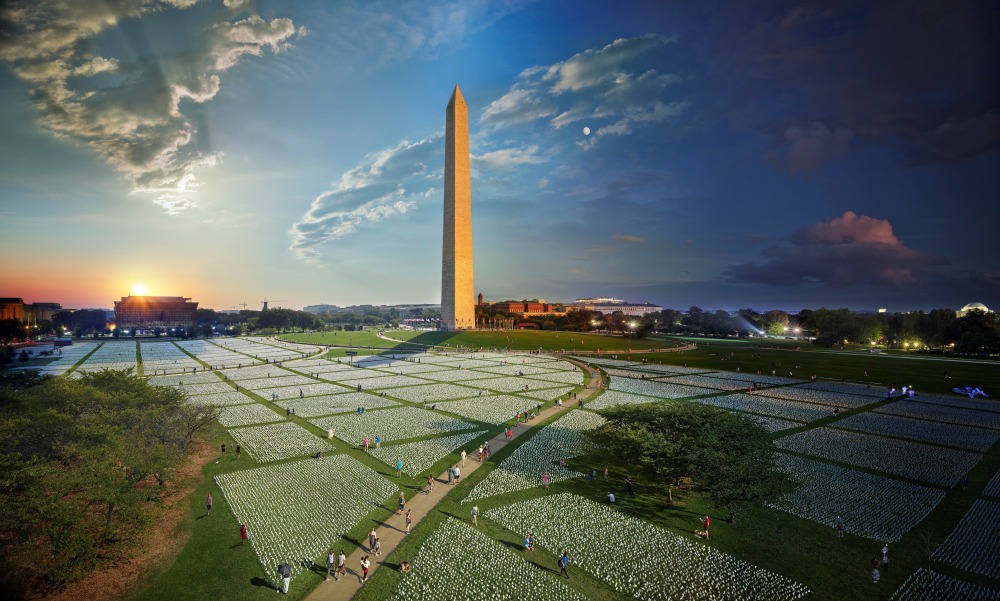
History & Culture
Coronavirus Coverage
The epic COVID-19 memorial on the National Mall, in one stunning photo
4,882 photos taken over 30 hours. More than 670,000 flags representing American lives lost. An incalculable measure of grief.
By: Rachel Hartigan
Published September 30, 2021
For more than 30 hours, photographer and National Geographic Explorer Stephen Wilkes watched people move through the sea of white flags below him on the National Mall in Washington, D.C. He saw young children bend down curiously to examine the small flags, and cyclists lay down their bikes to take in the 20-acre expanse of them. He saw skateboarders roll through, selfie-takers frame shots—and passersby slowly realize that each flag represents a life lost to COVID-19.
On September 18 and 19, starting before sunrise and finishing after sunset, Wilkes took 4,882 photographs of the art installation In America: Remember, an exhibit that aims to convey the enormity of the country’s pandemic losses. He and his team then blended the photographs into a single composite image, part of his Day to Night series.
“One of the things I tried to capture was the epic scale of this,” says Wilkes. “It’s almost impossible to take it all in.”
To do so, Wilkes spent two days suspended 45 feet above the ground in a lift—high enough for a bird’s eye view but low enough to descry people’s gestures and body language. He positioned the lift purposely: He wanted the National Museum of African American History and Culture (shown on the left with the sun rising over it) to be a focal point because “so many people of color were dramatically impacted by this virus.”
The walkway was another focal point, which he used to draw viewers into the picture. In a bit of serendipity that he attributes to “the magic that sometimes happens when I photograph,” a sweeping cloud formed near the Washington Monument. “The path takes you up into the image,” Wilkes says, “and the clouds pull you around it.”
His camera angle was fixed in place so that all photos were shot from a single viewpoint. When he spotted “little moments, little vignettes,” he pressed the shutter.
Over the 13 years that Wilkes has been embarked on his Day to Night project, he’s photographed many significant events (presidential inaugurations, the 2020 Commitment March, the Tour de France) and iconic places (Yosemite, Coney Island, the Western Wall in Jerusalem). This one was different, he says, “because this was about a loss of life that’s unprecedented in American history.”
Suzanne Firstenberg, the visual artist who created In America, designed the installation to help people make sense of the staggering numbers. Those who lost a loved one to COVID-19 can personalize a flag with their name and a message or make a request through the exhibit’s website for a volunteer to inscribe a flag for them.
When visitors encounter those flags, Firstenberg wants them to think, “Oh my God, this person was a father, a mother, an uncle. The family’s grief must be immense,” she says, speaking two days before the exhibit opened on September 17. “The coworkers, the faith communities, the neighbors, all those concentric circles of grief surrounding that one flag—and then you lift your gaze, and you look at 660,000 other flags. It captures the essence of one family’s grief and yet magnifies it to the nation.”
When Firstenberg was planning the exhibit, she ordered 630,000 flags—preparing for what she thought would be the worst-case scenario. Soon she realized she’d have to order many more. On opening day, the death toll surpassed 670,000. Three days before the exhibit's live-streamed closing ceremony on October 3, it’s topped 693,000.
It would have been easy, says Wilkes, to make an image that dwelled upon the darkness of so much death. But Firstenberg created the installation to appeal to our common humanity, so “I wanted the image to reflect the sense of hope that we’re going to come forward out of this,” he says. “It’s a moment of reflection. And maybe a moment when we need to come together.”